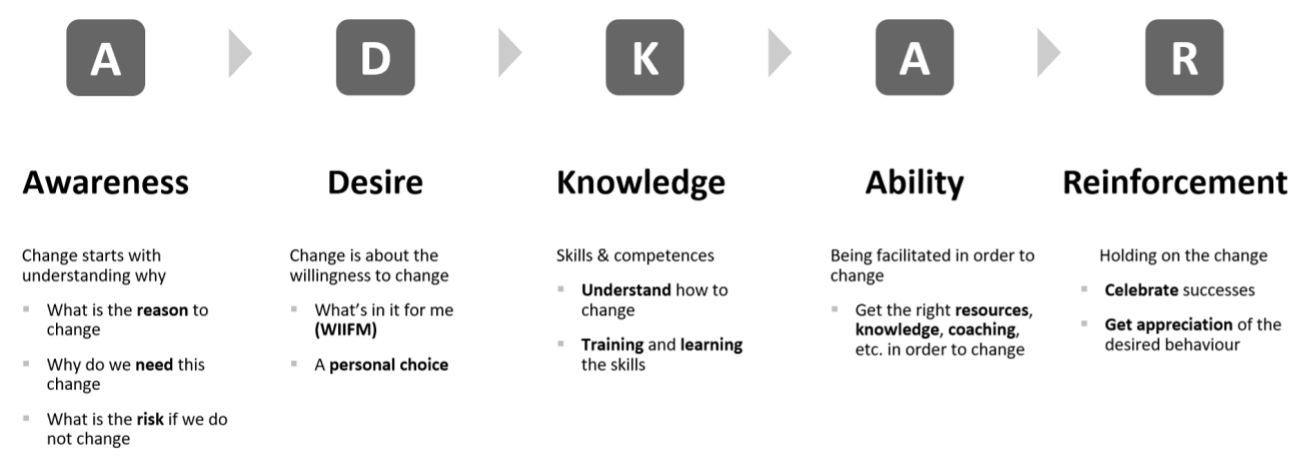Training and Transformation with the ADKAR Model

These days, it’s not a question of if your company will transform, it’s a question of when and how. And while new technologies may be driving much of the change, it’s people that need to use that technology. That makes creating a culture of learning vital to the continued success of any company. Transformation is part of the job now.
So how do you build that culture? How do you inspire and encourage learning and tailor your training programs to meet the needs of your people? The ADKAR model, part of the Prosci Methodology for change management, provides a blueprint for how to introduce, inspire, instruct, and reinforce new processes, supporting people in their transformation every step of the way. The name is an acronym for Awareness, Desire, Knowledge, Ability, and Reinforcement, the stages of the individual change management process that it suggests. A number of speakers from AU 2022 shared their experiences putting the ADKAR model into practice and the lessons they learned along the way.

Awareness and Desire
VolkerWessels is a global construction company focused on infrastructure. It has more than 60,000 employees at 100+ subsidiary companies in the throughout Europe and North America, and each company has their own way of working. Jeroen Tishauser, a civil engineer and information manager focused on change management at VolkerWessels, spoke in the AU Theater. His colleague, Jens Miedema, a civil engineer and a change manager focused on implementing BIM 360 and the Autodesk Construction Cloud, led a class. Both spoke about ADKAR in their sessions.
The first thing to know about the ADKAR approach is that it doesn’t start with training. Instead, it starts by building Awareness—communicating why change is needed and what’s at risk if change doesn’t happen.
“I’m aware of the technology, and then I want it, right? It’s like a new LEGO box,” Tishauser says. Miedma continues, “It all starts with being aware of what the change is about and understanding why it happens.”
Here, your sources matter. You want the right “sponsors” of the transformation—people who have authority and expertise to communicate this, Miedma says. You want to build awareness through multiple channels within your organization. And you can use 1-on-1 coaching to help people understand.
The next step after creating awareness is to encourage Desire—to make the change not only something they have to do, but something they want to do. “You need to know what the reason is to change,” Miedma says. “And then Desire—what’s in it for me?”
Resistance is a natural response to change—especially mandated change. So anticipating that resistance is crucial in the Desire phase, Tishauser points out. “I’m a civil engineer, so I focus a lot on risk management,” he says. “I want to mitigate the reason that people won’t want to change.”
This is also the phase where you benchmark your current performance indicators. This will prove key later in the process, when you need to quantify the ROI, Tishauser says.
Developing knowledge and new abilities
Once people know why they need to change and how they (and the company) will benefit, the actual training starts. This encompasses the Knowledge and Ability phases of the process.
Royal HaskoningDHV (RHDHV), an engineering consultancy based in the Netherlands, has made training and employee support a pillar of their business strategy. Sanne Douma is the digital learning and development lead and Hein Welman is BIM lead for digital services within the company. In their AU class, Equipping Staff for the Digital Future of Work, they shared their perspective on this phase of change management.
Training can take many forms—from classes to one-on-one coaching and beyond. RHDHV instituted “learning weeks” three times per year. “The goal is to facilitate peer-to-peer learning through bite-sized learning sessions that are available globally,” according to Douma and Welman. “One could compare it a virtual Autodesk University, but only intended for Royal HaskoningDHV internally.”
They also created a learning management system that not only distributes learning content, but also provides a fulcrum to assess development and facilitate conversations between employees and managers. With both on-demand classes and live sessions, available both virtually and in person, they enable the creation of personalized learning plans. “There is no one-size-fits-all solution,” they emphasize.
They also focus on training their leaders. “It is something we learned the hard way,” they say. “We’ve trained many employees on parametric design, and they are ready to take the next step. However, we have experienced that sometimes project managers and line managers can slow down the implementation when they are not aware of the new leadership style which is required from them. That’s why we now focus on management training, to make sure that they are enablers of the transformation.”
“It’s important to note that skills in digital transformation are not just the traditional tech skills,” they point out. “In fact, according to Deloitte, the rising tech skills in the future of technology are creativity, cognitive flexibility, and emotional intelligence.”
Reinforcing change
When people have gained the skills and the knowledge they need, the process isn’t over. The Reinforcement phase is essential to making the changes stick and building the learning culture. “You want to celebrate the success, celebrate the achievement people made,” Tishauser says. Miedma adds: “You must hold on to the change by using measurements and communication messages in order to reinforce it.”
In the case of VolkerWessels, this initiative exceeded the goals they set. They started with a goal of achieving 1500 active users of BIM360 and Autodesk Construction Cloud—and eventually reached more than 1700. They are using the new processes on more than 400 projects, a huge jump from their goal of 150 projects. And they achieved time optimization levels of 10% on coordination and review, a significant boost to their bottom line. For RHDHV, the goals are different—they’re aiming to provide 90% of employees with relevant digital skills and competencies, and the initiative is ongoing.
Every company is on a unique transformation journey. But whether you’re integrating BIM, cloud technologies, AR and VR, generative strategies, or something else entirely, when it comes to managing the “people side of the change,” the process is the same. As Miedma says, “Changes should not only be made at the organizational level, but maybe more importantly, also at a personal level.”
Learn more about effective methods to inspire, support, and encourage transformation in your workforce anytime at Autodesk University.




